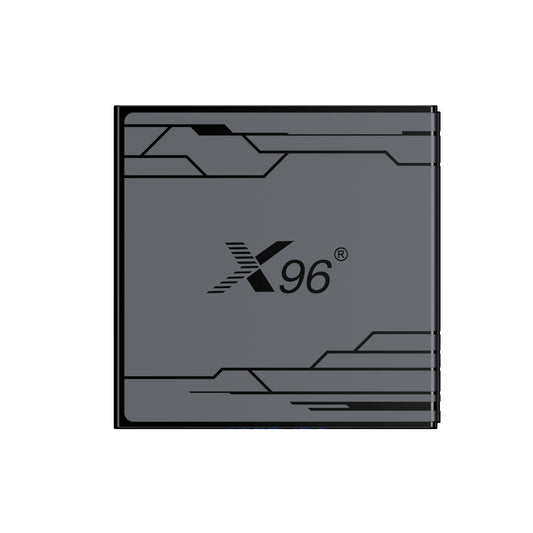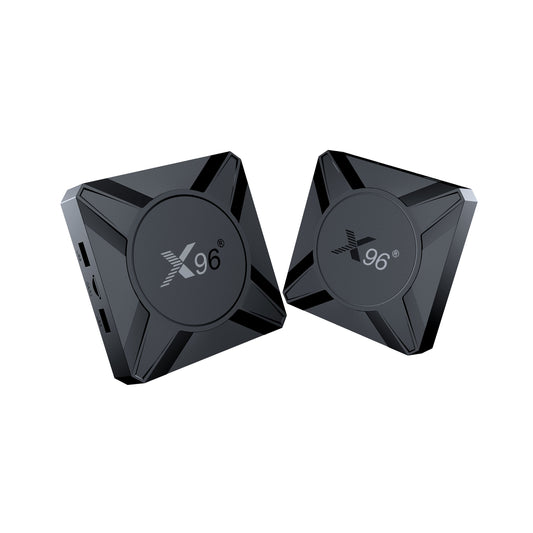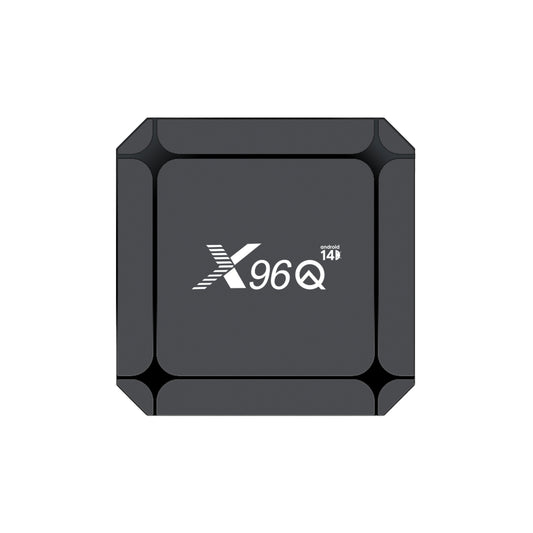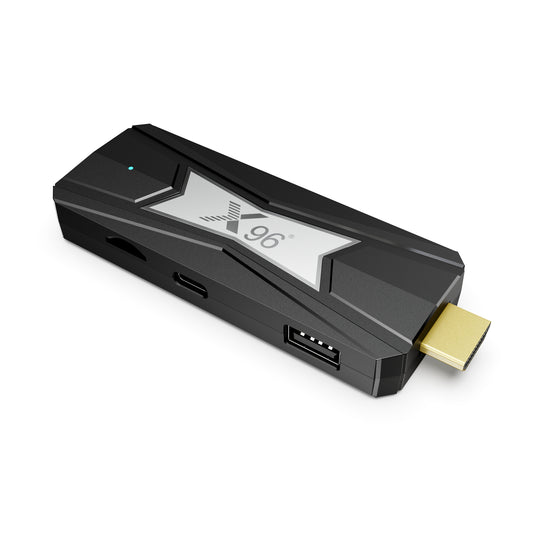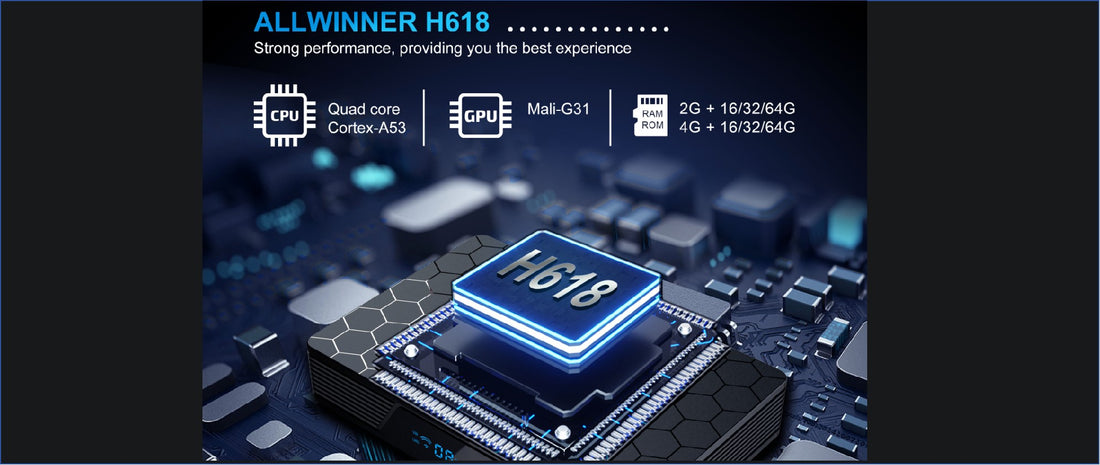
Allwinner H618 VS S905X4, RK3528, S905W2, RK3566,Linux Armbian & Review
1. Allwinner H618 CPU & Specs
The Allwinner H618 is a powerful System-on-Chip (SoC) designed primarily for multimedia applications, smart TVs, and various embedded systems. Here’s a detailed look at its CPU features:
H618 CPU
1. Architecture
The H618 CPU features a 64-bit ARM Cortex-A53 architecture, which is known for its balance of performance and energy efficiency. This architecture allows for better multitasking and improved performance in applications that require processing power.
2. Core Configuration
The H618 CPU integrates four Cortex-A53 cores, providing a quad-core configuration. This setup enables the chip to handle multiple tasks simultaneously, enhancing responsiveness and performance in multi-threaded applications.
3. Clock Speed
The H618 CPU cores in the H618 can operate at clock speeds of up to 1.5 GHz. This frequency allows for efficient processing of tasks, making it suitable for applications that require quick data handling and processing.
4. Performance
The combination of the Cortex-A53 architecture and quad-core configuration allows the H618 to deliver adequate performance for HD video playback, gaming, and general computing tasks. It is particularly effective for applications that require smooth multimedia playback and user interface responsiveness.
5. Energy Efficiency
The H618 is designed with energy efficiency in mind. The Cortex-A53 cores are optimized for low power consumption, making the SoC suitable for battery-operated devices and applications where thermal management is critical.
6. Support for Multimedia
The H618 CPU is complemented by powerful GPU capabilities, allowing it to handle high-definition video decoding and graphics rendering. This makes it ideal for streaming applications, smart TVs, and media players.
7. Compatibility
The Allwinner H618 supports various operating systems, including Android and Linux, providing flexibility for developers and manufacturers to create customized applications.

Allwinner H618 Specs
| CPU | Chipset | Allwinner H618 | ||
| Architecture | Quad core ARM Cortex A53 | |||
| GPU | Chipset | Mali G31 MP2 | ||
| RAM | Capacity | 4GB (2GB Optional) | ||
| ROM | Capacity | 32GB (16/64GB Optional) | ||
| External storage | USB Storage Devices | Supported | ||
| Software | ||||
| Operating system | OS Version | Android 12 | ||
| Language | Multi-Language | |||
| Multimedia | Video | Video Decoder: | ||
| H265 Main10@L5. 1 decoder up to 4K@60fps or 6K@30fps | ||||
| VP9 Profile 2 decoder up to 4K @ 60fps | ||||
| AVS2 Jizhun 10bit decoder up to 4K @ 60fps | ||||
| H.264 BP/MP/HP@L4.2 decoder up to 4K@30fps | ||||
| Multi-format 1080p @ 60fps video playback formats ,including H.264 BP/MP/HP , H 263 BP , VP8 , MPEG-1 MP/HL ,MPEG-2 MP/HL , MPEG-4 SP/ASP @ L5 , AVS +/AVS JizhunWMV9/VC1 , etc | ||||
| Video encoder: | ||||
| H.264 BP/MP/ HP encoder up to 4K@25fps or 1080p @ 60fps JPEG snapshot performance of 1080p @ 60fps | ||||
| Audio | MP3, AAC, WMA, FLAC, Ogg. | |||
| Image | HD JPEG、BMP、GIF、PNG、TIF | |||
| Network service | ||||
| Wi-Fi | Type | IEEE802. a/b/g/n/ac/ax (optional) | ||
| Frequency | 2 4GHZ ~ 5 . 8GHZ | |||
| Antenna Type | Inside antennas | |||
| Bluetooth | Bluetooth | BT5.0+ | ||
| Interface | ||||
| Charge | DC connector | DC 5V- 2A | ||
| Video output | HDMI | 1* 4K 2K Output, HDMI 2.0a | ||
| CVBS | Support PAL/NTSC | |||
| Video input | HDMI IN | 1* HDMI 1.4 RX input | ||
| OPTCAL | / | 1 * SPDIF | ||
| Ethernet | Ethernet | 1*Default 1000M( optional 100M) | ||
| TF Card | External memory | 1* TF Card | ||
| USB port | USB Host | 3 * USB 2.0 | ||
| Switch | KEY | Switch HDMI IN and HDMI OUT Signal | ||
| Upgrade | KEY | Update firmware | ||
| Others | RTC | Optional | ||
| Appearance | ||||
| Body Material | Plastic | |||
| Color | Black | |||
| Size | 135x90x23(mm) | |||
| Weight | 0.15Kg | |||
| Cerifications(For Unit) | ||||
| Standard | CE | / | ||
| RoHS | / | |||
| Others | Optional | / | ||
| Package contents | Shipping Info | |||
| User manual | *1 | Gift Box Dimension(mm) | 185*145*54mm | |
| Gift Box | *1 | Carton Size(mm) | 390*300*290mm | |
| Remote control | *1 | Qty Per Carton(pcs) | 20pcs | |
| HDMI external cable | *1 | Gift Box.G.W(gs) | 0.394Kg | |
| Power adapter | *1 | Export carton (G.W.)(kgs) | 8.88Kg | |
2. Allwinner H618 Linux Armbian
The Allwinner H618 SoC is increasingly gaining traction in the Linux community, particularly with the Armbian operating system. Armbian is a lightweight Debian- or Ubuntu-based distribution tailored for ARM development boards. Here’s a detailed look at the unique applications and benefits of using the Allwinner H618 Linux Armbian.
1. Optimized Performance
Armbian provides an optimized kernel and user space for the Allwinner H618, ensuring that the hardware capabilities are fully utilized. The lightweight nature of Armbian allows for faster boot times and efficient resource management, making it ideal for both desktop and embedded applications.
2. Multimedia Capabilities
The H618's powerful multimedia processing capabilities are well-supported in Armbian. Users can take advantage of hardware-accelerated video decoding and encoding, allowing for smooth 4K video playback and streaming. Applications like Kodi or Plex can be installed easily, turning the device into a capable media center.
3. Development Environment
Allwinner h618 Armbian offers a robust development environment for developers working with the H618. With access to a full suite of development tools and libraries, developers can create applications tailored to their needs. The extensive documentation and community support make it easier to troubleshoot and optimize applications.
4. IoT and Home Automation
The H618’s low power consumption and versatile connectivity options make it an excellent choice for IoT applications. Armbian supports various IoT frameworks, allowing users to build smart home solutions, including automation systems, sensors, and control interfaces.
5. Network Applications
With built-in Gigabit Ethernet support, the Allwinner H618 Linux can be utilized for networking applications. Armbian allows users to easily set up network services such as file servers (using Samba or NFS), web servers (using Apache or Nginx), or even VPN servers, enhancing the device's functionality as a home server.
6. Customization and Flexibility
Armbian provides a high degree of customization, allowing users to tailor the operating system to their specific needs. This flexibility is particularly beneficial for projects requiring specific software configurations or optimizations, whether for personal use or commercial applications.
7. Community Support
The Armbian community is active and supportive, providing forums, documentation, and tutorials. Users can find solutions to common issues, share their projects, and collaborate on software development, enhancing the overall experience of working with the H618 Linux.
8. Lightweight Desktop Environments
For those looking to use the H618 as a desktop machine, Armbian supports lightweight desktop environments such as XFCE or LXQt. This allows the device to run smoothly, even with limited resources, making it suitable for basic computing tasks.
Conclusion
The Allwinner H618 Linux Armbian, presents a powerful and versatile platform for a wide range of applications. From multimedia playback to IoT solutions, the synergy between the SoC and the operating system enables users to harness the full potential of their hardware. Whether you're a developer, hobbyist, or simply looking to explore the capabilities of ARM-based systems, the Allwinner H618 with Armbian offers a unique and rewarding experience.
3. X98H H618 TV Box
The X98H TV Box, powered by the Allwinner H618 SoC, is a versatile and budget-friendly streaming device designed for media consumption, gaming, and smart home integration. Here’s a closer look at its features, specifications, and applications:
1. X98H H618 TV Box Key Features
Powerful Processor:
- The Allwinner H618 features a quad-core ARM Cortex-A53 CPU, providing efficient performance for various applications, including streaming, gaming, and multitasking.
Graphics Performance:
- Equipped with a Mali-G31 MP2 GPU, the X98H supports smooth graphics rendering and playback of high-definition content, making it suitable for gaming and media playback.
4K Video Support:
- The device supports 4K resolution at 60fps, enabling users to enjoy ultra-high-definition content from streaming services and local media.
Memory and Storage:
- Typically, the X98H comes with 4GB of RAM and options for 32GB or 64GB of internal storage, expandable via microSD cards. This ensures ample space for apps and media.
Operating System:
- The X98H runs on Android, providing access to a wide range of apps through the Google Play Store, including popular streaming services like Netflix, YouTube, and Hulu.
Connectivity Options:
- The device includes multiple connectivity options:
- HDMI 2.0 for video output
- USB 3.0 and USB 2.0 ports for peripherals
- Ethernet port for wired internet connections
- Wi-Fi (typically dual-band) for wireless connectivity
Audio Support:
- Supports high-definition audio formats, ensuring a rich sound experience when watching movies or listening to music.
Remote Control:
- Comes with a remote control for easy navigation, allowing users to browse content and control playback effortlessly.
2. X96 X98H TV Box
The X98H is a 4K Android TV Box powered by the Allwinner H618 processor and features WiFi 6 for faster and more reliable wireless connectivity. 

4. Allwinner H618 VS S905X4, RK3528, S905W2, RK3566
1. Comparison table outlining the specifications of the Allwinner H618, S905X4, RK3528, S905W2, and RK3566 SoCs
| Feature | Allwinner H618 | S905X4 | RK3528 | S905W2 | RK3566 |
| CPU Architecture | ARM Cortex-A53 (Quad-core) | ARM Cortex-A55 (Quad-core) | ARM Cortex-A53 (Quad-core) | Quad Core ARM Cortex A35 | ARM Cortex-A55 (Quad-core) |
| GPU | Mali-G31 MP2 | Mali-G31 MP2 | Mali-450 | Mali-G31 MP2 | Mali-G52 |
| Video Decoding | 4K@60fps | 4K@60fps | 4K@60fps | 4K@60fps | 4K@60fps |
| Video Encoding | 4K@30fps | 4K@60fps | 4K@30fps | 4K@30fps | 4K@60fps |
| Memory Support | DDR3/DDR4 (up to 4GB) | DDR4 (up to 8GB) | DDR3/DDR4 (up to 4GB) | DDR4 (up to 4GB) | LPDDR4 (up to 8GB) |
| Storage | eMMC, microSD | eMMC, microSD | eMMC, microSD | eMMC, microSD |
eMMC, microSD |
| Connectivity | HDMI 2.0, USB 3.0/2.0, Ethernet, Wi-Fi | HDMI 2.1, USB 3.0/2.0, Ethernet, Wi-Fi | HDMI 2.0, USB 2.0, Ethernet, Wi-Fi | HDMI 2.0, USB 3.0/2.0, Ethernet, Wi-Fi | HDMI 2.1, USB 3.0/2.0, Ethernet, Wi-Fi |
| Audio Support | HD Audio | HD Audio | HD Audio | HD Audio | HD Audio |
| Applications | Smart TVs, Media Players | Smart TVs, Media Players | Smart TVs, Media Players | Smart TVs, Media Players | Smart TVs, Media Players |
1. Allwinner H618 vs S905x4
Allwinner H618
Advantages:
- Cost-Effective: Generally more affordable, making it suitable for budget devices.
- Good Multimedia Performance: Supports 4K video decoding at 60fps, which is sufficient for most streaming applications.
- Energy Efficiency: Designed for low power consumption, making it ideal for embedded systems and cost-effective devices.
- Wide Compatibility: Compatible with various operating systems and software, enhancing versatility in applications.
Disadvantages:
- Lower Clock Speed: Max clock speed of 1.5 GHz may limit performance in more demanding applications compared to higher-end SoCs.
- Limited GPU Performance: The Mali-G31 MP2 is adequate for basic tasks but may struggle with more intensive graphics applications.
- Memory Limitations: Supports up to 4GB of DDR3/DDR4 RAM, which may not be sufficient for multitasking in more advanced setups.
S905X4
Advantages:
- Higher Performance: Features a quad-core Cortex-A55 CPU with a clock speed of up to 2.0 GHz, providing better performance for demanding applications.
- Advanced GPU: Equipped with the Mali-G31 MP2, offering improved graphics performance for gaming and multimedia tasks.
- Enhanced Video Support: Supports 4K video decoding at 60fps and 4K encoding at 60fps, making it suitable for high-quality streaming.
- More RAM Support: Can support up to 8GB of DDR4 RAM, allowing for better multitasking and performance in resource-heavy applications.
Disadvantages:
- Higher Cost: Typically more expensive than the Allwinner H618, which may not be ideal for budget-conscious projects.
- Power Consumption: While still efficient, the higher performance may lead to slightly increased power consumption compared to the H618.
- Complexity in Development: May require more advanced development skills due to its enhanced features and capabilities.
In the comparison of Allwinner H618 vs. S905X4, the Allwinner H618 is a great choice for budget devices and basic multimedia applications, offering good performance at a lower cost. In contrast, the S905X4 is better suited for high-performance applications, advanced gaming, and multitasking, but comes at a higher price point.
2. Allwinner H618 vs RK3528
The Allwinner H618 and RK3528 are both popular System-on-Chips (SoCs) used in various multimedia and embedded applications. Below is a detailed comparison focusing on their specifications, performance, and use cases.
Allwinner H618
Specifications:
- CPU: Quad-core ARM Cortex-A53
- Clock Speed: Up to 1.5 GHz
- GPU: Mali-G31 MP2
- Video Support: 4K@60fps decoding
- Memory Support: Up to 4GB DDR3/DDR4 RAM
- Connectivity: HDMI 2.0, USB 3.0, Ethernet, and more
- Applications: Smart TVs, set-top boxes, and low-cost devices
Advantages:
- Cost-Effective: The Allwinner H618 is typically more affordable, making it suitable for budget-friendly devices.
- Energy Efficiency: Designed for low power consumption, making it ideal for embedded systems.
- Adequate Multimedia Performance: Good for streaming and basic gaming, supporting 4K video playback.
Disadvantages:
- Limited GPU: The Mali-G31 MP2 may not handle high-end gaming or graphics-intensive tasks efficiently.
RK3528
Specifications:
- CPU: Quad-core ARM Cortex-A53
- Clock Speed: Up to 1.8 GHz
- GPU: Mali-450 MP2
- Video Support: 4K@60fps decoding and encoding
- Memory Support: Up to 4GB DDR3/DDR4 RAM
- Connectivity: HDMI 2.0, USB 3.0, Ethernet, and more
- Applications: Smart TVs, set-top boxes, and media players
Advantages:
- Enhanced Video Capabilities: Supports both decoding and encoding of 4K video, making it suitable for content creation and streaming.
- Robust Ecosystem: The RK3528 has a strong developer community and support for various operating systems.
Disadvantages:
- Cost: Generally more expensive than the Allwinner H618, which may not be ideal for budget projects.
- Power Consumption: While still efficient, the higher clock speed may result in slightly increased power usage compared to the H618.
Summary: Allwinner H618 vs. RK3528
In the Allwinner H618 vs. RK3528 comparison, the Allwinner H618 is a cost-effective choice for basic multimedia applications, suitable for budget devices. In contrast, the RK3528 offers enhanced performance and video capabilities, making it a better option for higher-end applications and content creation.
3.Amlogic s905w2 vs Allwinner h618
When it comes to budget-friendly multimedia solutions, the Amlogic S905W2 vs Allwinner H618 debate is one that many tech enthusiasts face. Both SoCs offer unique advantages, but they cater to different needs and applications. Let’s dive into the specifics of Amlogic S905W2 vs Allwinner H618.
Graphics Capabilities
Both SoCs feature the Mali-G31 MP2 GPU, but the performance nuances come into play during intensive graphics tasks. The Amlogic S905W2 vs Allwinner H618 showdown reveals that while both can handle 4K video playback, the former excels in graphics rendering, making it a better choice for gaming and multimedia applications.
Video Output and Multimedia Support
In terms of video output, the Amlogic S905W2 supports HDMI 2.1, allowing for advanced video technologies and higher frame rates. In contrast, the Allwinner H618 supports HDMI 2.0, which, while still capable, does not offer the same level of performance. This aspect of the Amlogic S905W2 vs Allwinner H618 comparison is crucial for users who prioritize high-definition content viewing.
Energy Efficiency
One of the standout features of the Allwinner H618 is its energy efficiency. Designed for low power consumption, it is an ideal choice for embedded systems and long-term usage. In the S905W2 vs H618 discussion, the latter shines for projects where power savings are a priority, making it suitable for budget-conscious consumers.
Cost Consideration
When discussing the Amlogic S905W2 vs Allwinner H618, cost is a significant factor. The Allwinner H618 typically comes at a lower price point, making it an attractive option for cost-sensitive projects. On the other hand, the Amlogic S905W2 offers premium features that justify its higher price, especially for applications demanding robust performance.
4.Allwinner H618 vs RK3566
When comparing the Allwinner H618 vs RK3566, both SoCs present compelling features tailored for different applications. Let’s explore their key differences and strengths.
Performance
In the Allwinner H618 vs RK3566 matchup, the RK3566 takes the lead with its quad-core ARM Cortex-A55 architecture, offering higher clock speeds and better overall performance. The Allwinner H618, with its Cortex-A53 cores, provides adequate performance for basic tasks but lags behind in demanding applications.
Graphics Capabilities
The RK3566 features a Mali-G52 GPU, which delivers superior graphics performance compared to the Mali-G31 in the Allwinner H618. For users focused on gaming or high-definition video playback, the Allwinner H618 vs RK3566 comparison clearly favors the RK3566 for its enhanced multimedia capabilities.
Video Output
Both SoCs support 4K video output, but the RK3566 offers HDMI 2.1, allowing for advanced features like higher refresh rates. In contrast, the Allwinner H618 supports HDMI 2.0, making the Allwinner H618 vs RK3566 debate significant for those prioritizing cutting-edge video technology.
Energy Efficiency
The Allwinner H618 is designed for low power consumption, making it ideal for energy-sensitive applications. However, the RK3566 also provides competitive energy efficiency while delivering higher performance. Thus, the Allwinner H618 vs RK3566 discussion highlights the trade-off between power savings and processing power.
Cost
In terms of pricing, the Allwinner H618 typically comes at a lower cost, making it a budget-friendly option. The RK3566, while pricier, justifies its cost with superior performance and features. Depending on your budget, this factor plays a crucial role in the Allwinner H618 vs RK3566 decision.
6. Allwinner h618 Review
In this Allwinner H618 Review, we’ll explore the features, performance, and applications of this versatile SoC, highlighting what makes it a compelling choice for various multimedia and embedded systems.
Performance Overview
The Allwinner H618 is built on a 64-bit ARM Cortex-A53 architecture, featuring a quad-core configuration that clocks up to 1.5 GHz. In our Allwinner H618 Review, we found that this SoC performs adequately for everyday tasks and multimedia playback, making it suitable for budget-friendly devices.
Graphics Capabilities
One of the standout features in this Review is its GPU performance. The integrated Mali-G31 MP2 GPU supports 4K video decoding and encoding, allowing for smooth video playback. While it may not compete with higher-end SoCs, the graphics capabilities show it can handle most streaming needs effectively.
Energy Efficiency
Energy efficiency is another highlight in our Allwinner H618 Review. With its low power consumption design, the H618 is perfect for devices that require long operational times without frequent recharging. This makes it an excellent choice for IoT applications and home entertainment systems.
Connectivity Options
In terms of connectivity, the H618 supports various interfaces, including HDMI 2.0, USB 3.0, and Ethernet. This versatility is noted in our Allwinner H618 Review, making it adaptable for different applications, whether it’s a smart TV box or a media player.
Applications
The Allwinner H618 is well-suited for a range of applications, including smart TVs, set-top boxes, and IoT devices. In this Allwinner H618 Review, we highlight its capability to handle multimedia tasks efficiently while remaining cost-effective, making it a popular choice among manufacturers.
7. Conclusion
The Allwinner H618 is a versatile SoC designed for multimedia applications, featuring a quad-core Cortex-A53 architecture and capable of 4K video playback. In our Allwinner H618 Review, we highlighted its energy efficiency and suitability for budget-friendly devices, making it an attractive option for consumers looking for cost-effective solutions.
When comparing the Allwinner H618 to competitors like the S905X4, RK3528, S905W2, and RK3566, several distinctions emerge. The S905X4 offers a more powerful Cortex-A55 configuration, enhancing performance for demanding tasks. The RK3528, while featuring a similar Cortex-A53 architecture, serves as a more basic entry-level option, lacking some advanced features. The S905W2 provides additional benefits such as integrated AV1 decoding, making it well-suited for streaming applications.
In contrast, the RK3566 stands out with its superior performance capabilities, utilizing a quad-core Cortex-A55 and Mali-G52 GPU, making it ideal for a wider range of applications, including gaming and high-definition media playback.
All these SoCs run well on Linux Armbian, providing a stable environment for various projects. Ultimately, the choice between the Allwinner H618 and its competitors should be guided by specific use cases and budget considerations, with each chip offering unique advantages tailored to different needs.

